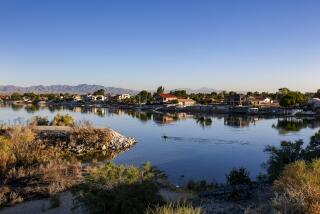Water Flows Very Freely in Phoenix
- Share via
PHOENIX — The smoke from Stephanie Hanley’s cigarette wafts up, blending with the wet haze created by a mister that is keeping her cool by spraying a light shower from the roof of a downtown coffee shop.
The Maryland transplant talks about her pool here and her lush yard filled with oleanders, rosemary and birds of paradise. She, like many others in this desert city, doesn’t worry about water.
“In 100 years, we might have a problem,” Hanley said. “Is it going to affect my generation? I don’t think so.”
As cities in other parts of the West struggle to conserve water in the face of a drought that has been gripping the region for years, Phoenix is going about business as usual.
Not only are there no mandatory water restrictions, but some people who let their lawns die are ticketed. Some homeowner associations require winter lawns, said Dallas Reigle, senior hydrologist with the Salt River Project, one of the city’s water suppliers.
“The irony is that a city in the desert in the middle of one of the meanest droughts we have ever had is telling a citizen he has to water his land,” Reigle said.
This July was the hottest and driest in the Southwest in 109 years, said Douglas LeComte, senior meteorologist with the National Drought Mitigation Center.
Torrential rain last week brought flash flooding but no real relief; the dry land could not absorb the deluge.
But even with the searing temperatures, including days on end of triple-digit heat in Phoenix, you can sometimes almost forget that the nation’s sixth-largest city rests in the middle of the desert.
Before they even land, people flying into Phoenix Sky Harbor International Airport can see a 560-foot jet of water bursting from an artificial lake. The jet is listed in the Guinness Book of Records as being the highest fountain.
Once in the city, people can play at golf courses that are watered year-round, lounge at one of about 200 parks -- 50 of which the city flood-irrigates -- or take a dip in one of the city’s 28 pools.
Most restaurants have misting systems that make it possible to dine outside, even in triple-digit heat. Paddle-boaters and kayakers can enjoy suburban Tempe’s man-made Town Lake.
The conspicuous consumption doesn’t stop there.
About 20,000 Phoenix residents have their lawns drenched by a flood-irrigation system, said Tom Babcock, the city’s water-conservation coordinator. Besides having lush yards, many people here, like Hanley, own pools.
It’s also not uncommon to see homes with sprinkler systems that seem to get as much water on sidewalks as they do on the lawn.
It’s possible to afford such luxuries because water is cheaper here than in many other places, said the city’s assistant financial director, Jeff DeWitt. On average, single-family households in the city of Phoenix use 11,200 gallons per month at a cost of about $19.64, before taxes and fees are added.
Nationwide, single-family households on average use 11,220 gallons per month at a cost of about $25.05, before taxes and fees are added.
“As a society, we tend to waste what is the cheapest,” DeWitt said. “We don’t respect it until it is too late.”
This disregard for the natural conditions of the desert has been developing over the last century as growth here has surged and people from less-arid climates have brought in their non-desert attitudes, habits and ethics, Babcock said.
“Phoenix sees itself more an oasis in the desert rather than a community living with the desert,” he said.
Mike Wilkins, a Chicago native who moved here a few years ago, said if the drought were truly a problem, restrictions would be implemented.
“It seems like this is the alarm scare of the month,” said Wilkins.
Phoenix isn’t as vulnerable as some cities to running out of water because multiple sources supply the metropolitan area of about 3 million people.
The Salt River Project delivers surface water from the Salt and Verde rivers. The Central Arizona Project delivers water from the Colorado River. Groundwater is pumped from wells by SRP and by individual cities.
But continued drought can bode ill.
Besides the drought, water officials are also concerned about the area’s explosive growth. Phoenix remains one of the fastest-growing cities in the country.
“This land was a desert before we got here, and it will be a desert when we leave,” Reigle said.
“We can’t change that,” he added. “We can only change how we conduct our personal business.”
More to Read
Sign up for Essential California
The most important California stories and recommendations in your inbox every morning.
You may occasionally receive promotional content from the Los Angeles Times.










